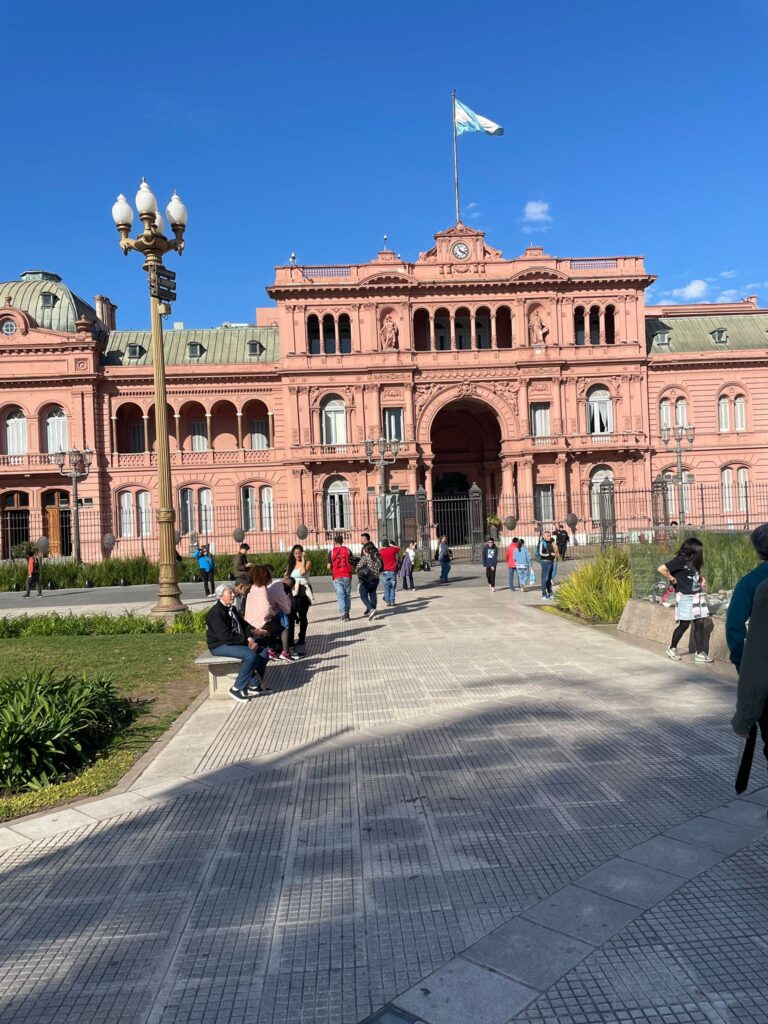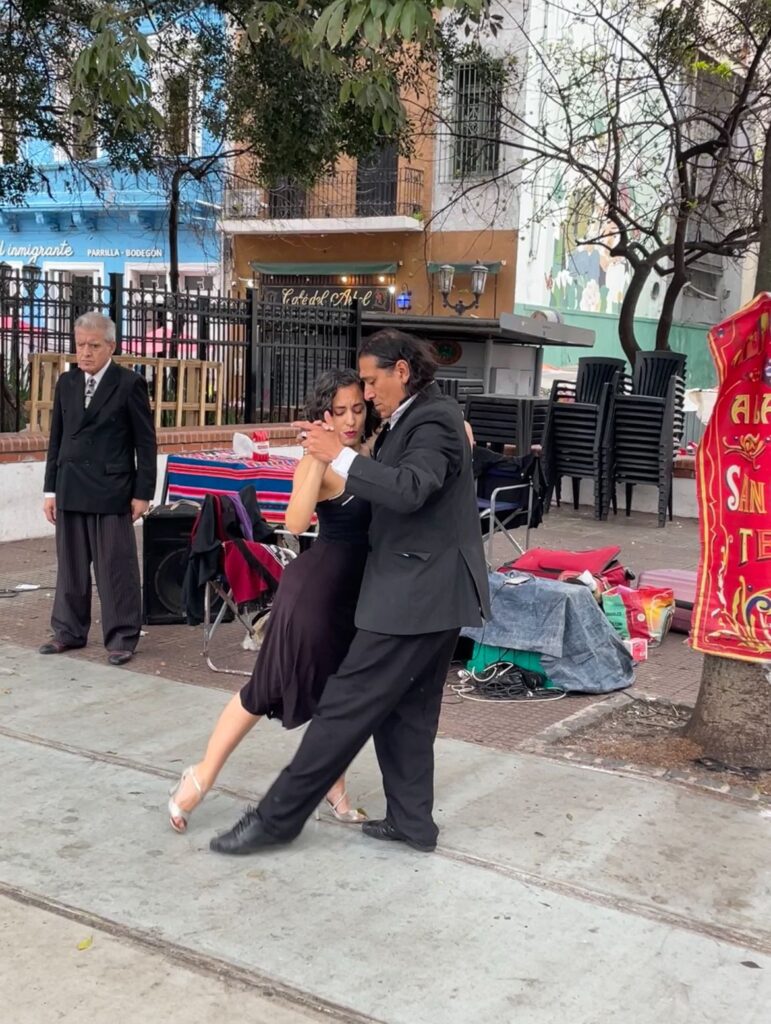Buenos Aires vs Rio de Janeiro: Which is Better to Visit?
Disclaimer: Some links on this page may be affiliate links. If you purchase anything through them, I will receive a small commission at no extra cost to you! Further details in the Privacy Policy.
Buenos Aires vs Rio de Janeiro… a clash between two of South America’s most famous cities.
Many travellers will only have the time or the budget to visit one. But which should you choose?
I’ve been to both cities multiple times, and will compare them on a variety of factors including activities, safety, costs, transport, accommodation and much more.
At the end, I will reveal which of these South American mega cities is better overall and should be top of your travel wishlist.

Things To Do
Buenos Aires
Buenos Aires has lots of activities to keep you entertained. It is the home of tango dancing and some of the world’s best steak.
You can have breakfast in Cafe Tortoni, a famous Parisian-style venue which was popular with intellectuals and celebrities ranging from Einstein to Katy Perry.
The quirky La Boca neighbourhood showcases Argentine culture at its finest with great steak, numerous tango performances and vibrant buildings. It is also home to Boca Juniors Football Club.
Jardin Japones is a relaxing Japanese garden. My girlfriend dragged me here, and it’s definitely most popular among couples, but to be fair it was pretty cool and I’m glad we went.
You can admire Buenos Aires’ most impressive architecture and historical spots such as the Palacio del Congreso and Plaza de Mayo. I’d recommend taking a free walking tour which covers both of these and more.
Recoleta Cemetery is the resting place of revered Argentinian politician Eva Peron. It’s also a very scenic spot.
Plaza Dorrego in San Telmo is where you can see tango dancing in the streets on a daily basis.
For nightlife, check out posh Palermo, or Puerto Madero which has some nice bars by the waterfront.
For more details, check out my 24-hour Buenos Aires itinerary. And have a look at more amazing activities below! ⬇️
Rio de Janeiro
Rio also has loads of cool activities on offer.
We can’t ignore one of the Seven Wonders of the World in the form of Christ the Redeemer. You can take a train up Corcovado Mountain, and if the weather is on your side (it was foggy during both my visits), then you should be able to see Jesus towering over Rio.
Another of Rio’s best attractions is Sugarloaf Mountain. And you get some pretty fantastic views of the city from up there. Great place to chill and enjoy a beer whilst watching the world go by.
Completing Rio’s biggest attractions are Copacabana and Ipanema Beaches. These world-famous spots have loads of people swimming, playing sports, relaxing, drinking and more.
Elsewhere, one of the most interesting activities in my eyes was a tour of Favela Rocinha which gave a really interesting insight into how locals live in these notoriously tough neighbourhoods.
Another memorable thing I did in Rio was going to a football match at the Maracana. I saw a highly entertaining 2-2 draw between Fluminense and Botafogo, and it was the best match I’ve been to for atmosphere from 38 countries to date. You should definitely try and go to a game if there’s one on during your visit.
Fancy splashing out? Well you can even take a helicopter tour around Christ the Redeemer for a memorable experience.
The best way to enjoy a smooth trip to Rio is by booking activities before you go. ⬇️
Verdict
Both cities offer plenty to keep you entertained. And that’s why both are so popular.
I enjoyed my time in La Boca, San Telmo, and other cool parts of Buenos Aires, but there’s only one winner here.
And that’s Rio de Janeiro.
It has a Wonder of the World, amazing views from above, world famous beaches, fascinating favela excursions, some of the best football experiences on the planet, and even helicopter tours.
It’s hard to compete with that.
Buenos Aires 0-1 Rio de Janeiro
Safety
Buenos Aires
Argentina is one of the safest Latin countries. Crime is generally low across the country, and whilst it’s a little higher in the capital, Buenos Aires is not a dangerous city.
The one area you do need to be wary of is near La Boca. The touristy parts are fine, but two things to remember are not to stay there after dark, and not to walk in the surrounding areas.
Admittedly I walked back from La Boca during my first visit in 2022 and nothing happened, but that wasn’t a wise idea. Use Uber instead.
Be careful exchanging money on Florida Street. Scams are rife here. Do your research on how to get the best exchange rates before doing anything. We only avoided getting scammed because I took the time to count out over 500 notes before leaving, despite attempts to rush us away.
You shouldn’t walk around with your phone out either, otherwise you’re at risk from motochorros (thieves on motorbikes who work in pairs to steal phones).
Read more on how to stay safe in Argentina, including in Buenos Aires.
Rio de Janeiro
Rio has a reputation for being a dangerous city. And whilst you can stay safe if you take the right precautions, you do need to be on your guard here.
I didn’t have any issues during either of my Rio trips. But you can certainly feel an edge to the place.
You should always use Uber to get around in Rio (even though it’s frustrating to use and drivers often cancel), and never take local buses.
Never enter a favela without being on a tour with a local guide. Foreigners have been shot for entering the wrong areas by accident in the past. A trusted guide is essential for your safety in these parts.
And it can be hard to notice the entry to a favela when they are intertwined so closely together.
The unfortunate truth is that Rio is a dangerous city, and you always need to be on your guard here.
In all honesty, Brazil ranks towards the bottom of South America’s safest countries.
Verdict
A clear win for Buenos Aires. The Argentine city is one of the safer capitals in South America, whereas Rio is one of the more dangerous cities on the continent.
Just make sure you have great travel insurance to cover you in case anything goes wrong. I spent over £1,000 (US$1,250) on medical bills in Uruguay, and had them reimbursed thanks to my travel insurance.
I’ve heard many horrors stories from people who travelled with no insurance and lost just about everything…
Buenos Aires 1-1 Rio de Janeiro

VisitorsCoverage Insurance
Don’t risk being left with a possible $100,000+ bill if something goes wrong on your travels.
Click on the link below to avoid a stressful trip, protect yourself, and know that you will be covered in emergency situations.
Costs
Buenos Aires
Back during my first visit in 2022, Buenos Aires was ultra cheap. Mostly thanks to the Blue Dollar, a black market exchange which offered you double the exchange rate if you handed over US dollars for pesos.
However, the 2023 election of Javier Milei has seen seismic policy changes to try and fix Argentina’s battered economy.
As a result the Blue Dollar is no longer so favourable to foreign tourists. From being worth 100% more than the official rate in 2022, it was only 25% better by my return to Argentina in September 2024.
As of February 2025, you can only gain 10% by using the Blue Dollar, and it’s only getting worse.
This means that Buenos Aires has become more expensive. Accommodation isn’t too bad still, however food prices have been rising on a regular basis, and Argentina appears to only be going up cost wise in the near future.
Rio de Janeiro
In Rio, things have gone the other way. Brazil was one of South America’s more expensive countries during my first visit in 2022. However the value of the real has dropped since, making Rio more affordable 3 years later.
Now, it is still much more expensive than the rest of Brazil. Accommodation isn’t cheap here, and you need to spend more on a place to stay in order make sure you’re in a safe area (Ipanema, Copacabana or Leblon).
However Uber is still cheap, as are meals out and groceries. Activities will put a dent in your budget though.
Overall, Rio is currently a mid-range destination, rather than an expensive one.
Verdict
I first visited both cities in 2022. Back then, Buenos Aires was by far the cheaper option.
However, things have changed with Rio becoming slightly more affordable, and Buenos Aires becoming much more expensive,
To be honest, there’s not much to choose between the two cities now in terms of costs.
Verdict: draw.
Buenos Aires 1-1 Rio de Janeiro
Beaches
Buenos Aires
Argentina is brilliant when it comes to almost everything… but not beaches.
And Buenos Aires has even less to offer on that front.
Locals will generally head down the coast to Mar del Plata, or across the border where they can visit Punta del Este in neighbouring Uruguay.
Buenos Aires is pretty forgettable in terms of beaches.
Rio de Janeiro
Rio has two of the most famous beaches in the world: Ipanema and Copacabana.
I must admit, they are quite overrated. During the day, they’re absolutely packed with locals, tourists and vendors. By night, they become dangerous places to hang around.
I recommend going at sunrise. That’s when you get the beach almost to yourself. We could count the people when we went to Copacabana at 5am. And that was the only enjoyable time to be there really.
Sunset is the other cool time to see the beaches, but it’s best to leave quickly as it starts getting too dark.
Verdict
Despite being a coastal city, Buenos Aires is just as famous for its beaches as Paris or London.
In other words… not at all.
As I say, Rio’s beaches are pretty overrated. But if you’re going for beach life, then there’s only one winner here, and that’s Rio.
Buenos Aires 1-2 Rio de Janeiro
Accommodation
Buenos Aires
As you may expect from a capital city, accommodation in Buenos Aires is a little more expensive than in most places across the country.
It’s still pretty reasonably priced though, despite the rising costs of almost everything in Argentina.
You can find a low quality hotel room for around £15/US$19 per night. From £20/US$25 you can start to find higher quality accommodation.
Hostels are great value in Buenos Aires, so I recommend checking out Hostelworld to find accommodation (many of them also have private rooms).
If you don’t find what you’re looking for, then Booking has plenty of options too.
Rio de Janeiro
Rio isn’t the easiest city in the world to find accommodation. You have to do thorough research before you book a place to stay.
You should stay in Leblon, Copacabana or Ipanema. And even then, read the reviews before you book. Our hostel was right at the bottom of a hill. Turns out it was just outside the entrance to a favela…
The quality of budget accommodation isn’t great. You really need to splash out to find anything decent in Rio.
Verdict
An easy win for Buenos Aires.
Far more options, far better prices and far better value for money in terms of quality.
Buenos Aires 2-2 Rio de Janeiro
Scenery
Buenos Aires
Buenos Aires is a city with a very European feel to it. The architecture is similar, and you can see a lot of impressive buildings in Monserrat, Palermo and Recoleta.
Buenos Aires isn’t a city full of giant skyscrapers, so don’t expect to find stunning aerial views here.
The narrow streets are often covered in shade, as large buildings sit close to each other, with little to see beyond more buildings.
On Avenida 9 de Julio, you have the famous Obelisk where millions gathered after Argentina won the 2022 World Cup.
La Boca is an interesting neighbourhood full of brightly-coloured buildings. It’s not to everyone’s taste, but it makes for a unique look which is part of the attraction really.
The best sights in Buenos Aires are covered here.
Rio de Janeiro
In Rio you can find stunning views of the city from above. One place to do this is Sugarloaf Mountain, where you can take a cable car up to view the surrounding bays, beaches, mountains and buildings in the city.
Christ the Redeemer on Corcovado Mountain is also said to have amazing views of Rio from above, but I can’t confirm this as I’ve been twice and it’s been foggy on both occasions!
And let’s be honest, you can’t get better than the views from a helicopter, which Rio can offer you.
The beaches are stunning at sunrise and sunset. But not so scenic in the day when packed with people.
Even the favelas have a certain charm about them. Their rugged appearance and contrast compared to the surrounding skyscrapers makes them an important part of the Rio de Janeiro cityscape.
Verdict
Both cities offer something different here, but I have to hand this one to Rio.
It has much more spectacular scenery from its high vantage points such as Sugarloaf and Corcovado Mountains. And can you really beat a helicopter tour? Not really.
Buenos Aires only wins on the scenery front if you’re really into the sort of architecture that you might find in Vienna, Budapest or Paris for example.
Rio has far more diverse scenery to offer however.
Buenos Aires 2-3 Rio de Janeiro

⭐️⭐️⭐️⭐️⭐️
Helicopter Tour of Rio de Janeiro
✅ Magical views of Rio from the air
✅ Up to 35 minutes in a doorless helicopter
✅ English, Spanish or Portuguese-speaking pilot
Food
Buenos Aires
It baffles me that “best food in the world” lists generally have Argentina in a mid-table position, if they’re even on the list in the first place.
Argentine cuisine is world class. I would say it’s the best I’ve ever discovered having been to over 70 countries at the time of writing.
You can order Argentine steak with a bottle of wine all over the best spots of Buenos Aires such as Monserrat, Palermo or Recoleta.
World-famous steakhouse Don Julio, loved by celebrities including Lionel Messi, is located in Palermo. And even if this popular dinner spot is a little out of your budget, there are plenty of other upmarket equivalents nearby.
Buenos Aires is a food Mecca.
Rio de Janeiro
You can find a lot of churrascarias in Brazil: steakhouses that generally have a large buffet, a small dessert selection, and several delicious meats.
They’re generally either all-you-can-eat for a set price (generally under £10/US$12) or you can pay by the kilo, meaning cost is based on the weight of your plate.
Rio is no exception. You can find some good ones in Copacabana and Botafogo.
Elsewhere, Shopping RioSul is a large mall with a good variety of chain restaurants from around the world.
Verdict
You may have guessed it, but Buenos Aires is a clear winner here. The only cities I’ve been to with better food than Buenos Aires are also in Argentina. Check out El Asadito in Mendoza if you ever get the chance.
Brazilian meat can be good at times. But the quality just doesn’t compare to its southern neighbour. Even in a big international city like Rio.
Buenos Aires 3-3 Rio de Janeiro
Transport
Buenos Aires
The Argentine capital has a metro to get around. It’s super cheap and safe to use.
Uber is my favourite method of transport in Buenos Aires. It’s cheap and generally reliable. Normally pretty easy to arrange a ride quickly too.
Another option is to take local buses. But really, Uber is so affordable that there’s no need.
If you want more freedom however, and the ability to go wherever you want inside or outside of Buenos Aires, then renting a car may be the best option for you.
Rio de Janeiro
I’d advise against using buses in Rio as they’re unsafe and muggings aren’t unheard of.
Locals have also cautioned us against using the metro here, which leaves Uber as the only real option.
Uber is the safe choice, but cars are unreliable, and drivers cancel frequently.
Don’t even think about renting a car in Rio de Janeiro. Only locals who know the area should drive here. Otherwise it’s possible to inadvertently drive into a favela which can be very dangerous.
Favela’s aren’t marked, so it’s not always easy to tell when you’re nearby (although small shacks built on hills is generally a clue).
Verdict
A clear victory for Buenos Aires. Rio simply isn’t safe enough to get around by public transport.
Even on the one thing where you can compare the two cities, Uber, it is much more reliable in Buenos Aires where cancellations are much rarer.
Buenos Aires 4-3 Rio de Janeiro
Walkability
Buenos Aires
Buenos Aires is an absolutely massive city. It would take around 3-4 hours to walk from end-to-end.
However, most parts of the city have zero interest to tourists and other visitors. Pretty much everywhere of interest is along the coast, or just a little back from it.
Around 2.5 hours separates Palermo, Recoleta, Monserrat, San Telmo and La Boca. These are the areas you will most likely be spending time in.
It’s a bit tricky to walk through all of them in one go (and as I said earlier, La Boca is not safe for this), however you can walk feasibly within each of these areas and around them without safety or logistical concerns.
Rio de Janeiro
Like Buenos Aires, Rio is massive and it would take several hours to walk from one end to the other. However, this is not a safe city at all to be wandering around.
You can walk within the safer areas of Copacabana, Ipanema and Leblon. However, even in these spots you should know where you’re going, not check maps without going inside a shop, and definitely don’t walk around at night.
Walking in Rio is a draining experience as you have to do your research and take safety very seriously. It really makes you appreciate cities like Singapore where you can go out without a care in the world.
Verdict
Another easy victory for Buenos Aires. It isn’t as walkable as many small, compact cities in Central or Eastern Europe. But it’s a far better place to explore on foot than Rio.
Rio on the other hand is one of the least walkable cities I’ve ever been to. Maybe one of the worst alongside Jakarta (Indonesia) and Yangon (Myanmar) which aren’t so unsafe, but barely have paths in many places.
Buenos Aires 5-3 Rio de Janeiro

Connectivity (Local SIM Cards)
Buenos Aires
It was a bit of hassle to get a SIM card here admittedly. They wouldn’t sell one to foreigners unless you bought the much more expensive tourist package which cost around £10/US$12. Not extortionate, but still a fair bit more costly than what locals pay.
ESIMs are an easier option that will save you this hassle. I always use Airalo (reviewed here) for mine. They’re very easy to use.
Rio de Janeiro
Rio (and Brazil in general) is the worst place in the world to get a SIM card. You need something called a CPF (a Brazilian tax number that tourists don’t have access to) in order to buy a SIM here.
Even if you get one, it’s unlikely you will be able to load data onto it without a CPF.
We found one place that would only sell us a package for a minimum of £30/US$38. No thank you…
The good news is that eSIMs are a lifesaver in Rio. They work without a CPF which make them the only viable way to get a SIM card here.
Make sure you get an eSIM before your trip to Rio. Again, I highly recommend using Airalo:
Verdict
Another victory for Buenos Aires.
The CPF makes connectivity in Rio a nightmare. Buenos Aires isn’t the smoothest city in the world to find a SIM, but at least it’s doable.
Buenos Aires 6-3 Rio de Janeiro
Weather
Buenos Aires
It’s not just the architecture and the culture that feels European in Buenos Aires. It’s the weather too.
The Argentina capital has a similar climate to southern Europe for most of the year.
The exception is during the summer from December-February, which is when it becomes quite a humid city to stay in, and it experiences a lot of rainfall.
There are no real extremes here with summers that can be uncomfortable, but not unbearable, and moderately cool winters.
Rio de Janeiro
Rio has a tropical climate, and it gets super humid here. You can feel the stickiness in the air just by walking around the city. I found it quite unpleasant at times.
It also rains a lot during the summer from December-February, with regular thunderstorms.
The winter from July-September is the best time to go, as this is when the humidity is at its lowest.
Verdict
This one is closer, but I’d give it to Buenos Aires, just.
Rio has greater extremes than Buenos Aires with the humidity playing a huge part in my ranking here. Although if we judged both cities only by their best, Rio would just about edge it.
Buenos Aires 7-3 Rio de Janeiro
Money
Buenos Aires
Argentina’s economy has been a mess for years. Inflation spiralled out of control, and it got to the stage where the peso became worth so little, that you could go to exchange money and come back with massive stacks of cash.
At times, I’ve had hundreds of pesos in my bag, which doesn’t feel safe to carry around, even in Argentina. There are too many notes to put them in your wallet.
It’s a little better now you can pay with card for most things, and you will only get slightly worse rates than with the Blue Dollar (cash-only black market exchange rate). But the money in Buenos Aires, and Argentina overall is a nightmare to deal with.
Rio de Janeiro
Brazilian money is easy to handle. The real has been losing value over the last couple of years, which makes Brazil more affordable than before.
You can pay with your card for most things here. Even when dealing with small street vendors.
Verdict
A very easy win for Rio. Brazilian money is far less hassle to deal with than Argentina’s money. And that doesn’t look like changing any time soon.
Buenos Aires 7-4 Rio de Janeiro

Best for Beginners
Buenos Aires
Buenos Aires is a very safe city with a lot of low-intensity activities. Most of the best things to do here involve tame walks or eating. It’s not a crazy adventure city at all.
The culture is also European, which makes it easy to travel here if you’ve ever spent time in Europe before. Europe is the perfect beginner spot for travellers.
English isn’t widely spoken, but you can still get by here without speaking fluent Spanish.
Get yourself an Airalo eSIM and it’s pretty easy to travel in Buenos Aires. I would say Argentina is the best starter spot in Latin America.
Rio de Janeiro
Rio has far too many safety pitfalls to be considered a good beginner spot. During my first 8-month Latin America trip, this was my very last stop. And that was a wise move. It’s good to spend a few months getting to know this region before you give Rio a go.
The language barrier can be tricky. If you’re used to travelling in Latin America, then you will probably be familiar with Spanish. Well, they speak Portuguese in Rio (and the rest of Brazil), so it can be a little trickier to get by, especially since English is rarely spoken here.
Rio is more of an adventure activity destinations with more adrenaline-based activities such as helicopter riding and favela tours.
Verdict
Buenos Aires is the perfect South America beginner spot, whereas Rio is more of an advanced destination.
The two cities couldn’t be further apart in their difficulty levels. Only the money situation is really easier in Rio. For everything else, it’s a clear Buenos Aires win.
Buenos Aires 8-4 Rio de Janeiro
So Buenos Aires vs Rio de Janeiro… Which City Comes Out on Top Overall?
I would say that Buenos Aires is a much better city than Rio de Janeiro when you take all things into account.
It’s much safer, much more beginner-friendly, the food is far better and it’s generally a much easier city to travel around than Rio.
Rio has its merits, and I would suggest you go there at least once for a week or so and check out the best activities that the city has to offer.
However danger is a major negative, and a big reason why I don’t rank Brazil highly amongst South American countries.
And Buenos Aires is the city with more longevity, the city that draws you back, and the city where you can feel most comfortable, regardless of whether it’s your first trip to South America, or your 50th.
I only went back to Rio a second time as my girlfriend had never been. I don’t really intend to go for a third. You can never fully rule it out, but Rio is a city with a lot of negatives, that counteract the positives in many ways.

More Posts on Argentina
- The 17 Best Cities In South America To Visit In 2025
- The Safest Countries In South America In 2025: Ranked
- Best Countries In South America To Travel To: Ranked
- The Best Things To Do In Buenos Aires: A 3-Day Itinerary
- Buenos Aires Vs Rio De Janeiro: Which Is Better To Visit?
- What Are The Best South American Countries For First Timers?
- What Are The 10 Safest Cities In South America In 2025?
- The Ultimate 6 Month South America Itinerary On A Budget
- Planning The Perfect Day Trip To Colonia From Buenos Aires
- Is Argentina Safe For Tourists To Travel To?
- Salta To Asuncion By Bus (Clorinda/Jose Falcon Border)
- How To Get From Salta To Uyuni By Bus (La Quiaca/Villazon)
- Where To See Penguins In Argentina On A Budget: Punta Tombo
- One Day In Buenos Aires: The Perfect 24-Hour Itinerary
- A 2 Week Patagonia Itinerary: From Ushuaia To Bariloche
- Best Things To Do In Ushuaia: Don’t Miss Out On This Gem!
- Cafe Tortoni: What To Expect In The Famous Buenos Aires Cafe
- Iguazu Falls Border Crossing: How To Cross The Triple Frontier Between Argentina, Brazil And Paraguay
- The Ultimate Guide To Visiting Iguazu Falls (Argentina Side)
- Money In Argentina: How To Get The Best Rates In 2024
- A 3-Week Argentina Itinerary: From Mendoza To Buenos Aires
- What To Do In Villa General Belgrano?
- How To Order Steak In Argentina
- Top 5 Things To Do In La Boca, Buenos Aires
- Safest Latin American Countries To Visit In 2025
More Posts on Brazil
- The 17 Best Cities In South America To Visit In 2025
- The Safest Countries In South America In 2025: Ranked
- Best Countries In South America To Travel To: Ranked
- Buenos Aires Vs Rio De Janeiro: Which Is Better To Visit?
- What Are The Best Things To Do In Rio De Janeiro?
- How To Get From Cayenne To Belem On A Budget
- The Ultimate 6 Month South America Itinerary On A Budget
- Iguazu Falls Border Crossing: How To Cross The Triple Frontier Between Argentina, Brazil And Paraguay

Great read and thank you for all these great tips! My husband and I would love to visit buenos aires in August but as a person of color, I’m second guessing as I’ve heard and read people saying that the locals are not too friendly with us. Can you give your insight on this? Thank you in advance!
In all honesty, Buenos Aires isn’t a city full of friendly locals. It has a bit of a big city mentality similar to London or New York to some extent, where people are often busy and you aren’t likely to experience the warmth and friendliness you may find in other parts of South America such as Paraguay, southern Brazil, Colombia or Venezuela for example.
It’s a fairly safe city, I cover safety in Buenos Aires a little more here.
But you are highly unlikely to end up in any serious danger or have any majorly unpleasant experiences here.